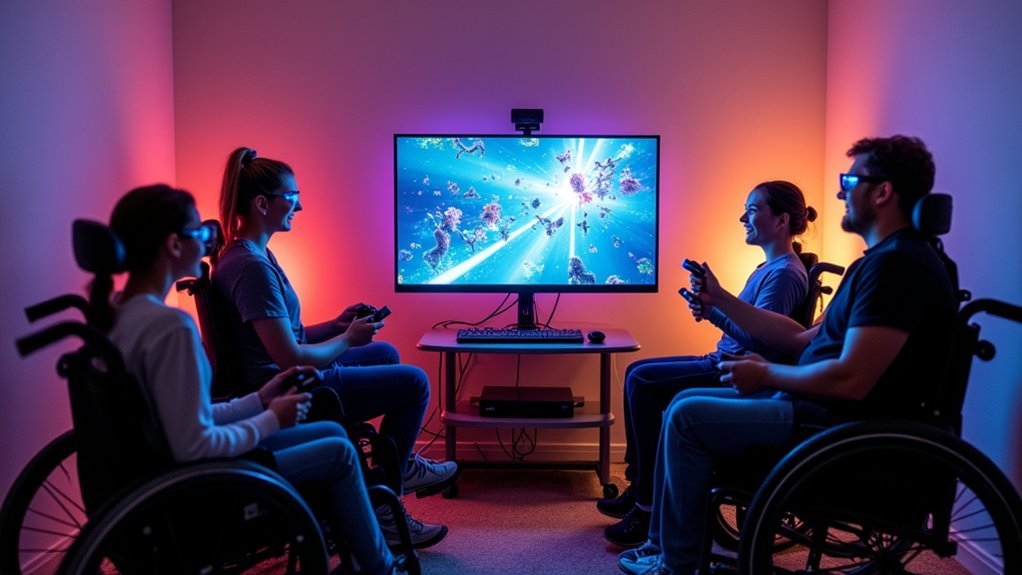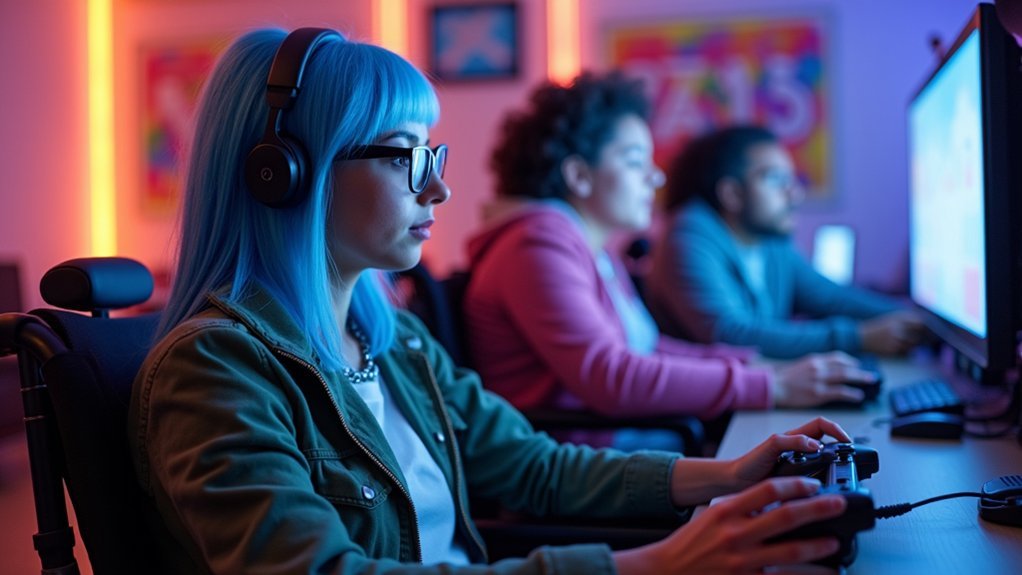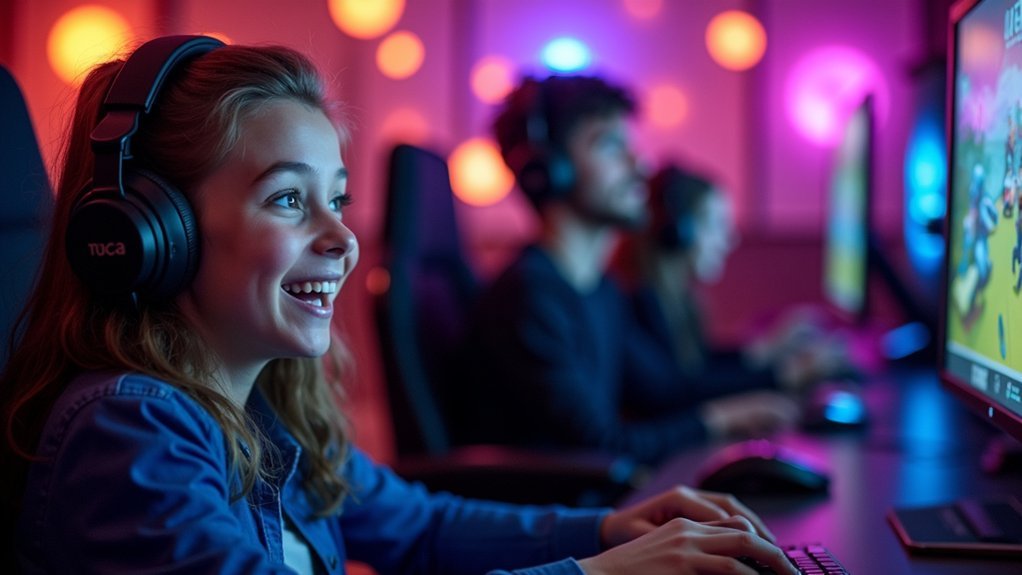Eye tracking technology enables you to control games with just your gaze, offering unprecedented accessibility for gamers with mobility challenges. With over 170 compatible titles across various genres, you’ll experience everything from precise aiming in shooters to natural cockpit scanning in flight sims. Setup requires minimal hardware—just connect a tracker like Tobii Eye Tracker 5, complete a simple calibration, and you’re ready to play. Discover how this revolutionary technology is transforming gaming into a truly inclusive space for all bodies.
Understanding Eye Tracking Technology in Modern Gaming
While many gamers focus on graphics cards and processors, eye tracking technology has quietly revolutionized how we interact with virtual worlds. Modern systems like Tobii’s Eye Tracker 5 use infrared light to precisely track where you’re looking on screen, supporting over 170 games across various genres. The technology provides remarkable versatility with its compatibility across various screen types, including flat, curved, and ultrawide displays.
You’ll find this technology enhancing both gameplay and immersion. In flight simulators like Microsoft Flight Simulator, your gaze can control camera movements, while action games use eye tracking for targeting and object selection. The technology tracks both head and eye movements simultaneously, creating a more intuitive gaming experience.
For content creators, tools like Tobii Ghost enable live streaming with customizable eye-tracking overlays, showing viewers exactly where you’re focusing during gameplay—adding a new dimension to engagement on platforms like Twitch.
Breaking Barriers: How Eye Control Transforms Gameplay for Disabled Gamers
Beyond enhancing gameplay for mainstream gamers, eye tracking technology has emerged as a transformative force in accessibility. You’ll find over 150 games supporting Tobii Eye Tracking, enabling control through eye movements alone—no traditional controllers needed.
For gamers with mobility impairments, eye tracking reduces physical strain while offering precise control over in-game actions. You’re able to shoot, navigate, and interact naturally with your gaze, making gaming more intuitive and engaging. This technology has evolved dramatically since Edmund Huey’s first device in 1898, which required subjects to wear uncomfortable contact lenses with aluminum pointers.
Developers are increasingly incorporating these features into their designs, often encouraged by vocal gaming communities advocating for inclusion. The technology adapts difficulty levels based on your gaze patterns, creating personalized experiences that respond to your unique needs.
This advancement doesn’t just allow participation—it guarantees you can enjoy gaming independently, bridging the gap to truly inclusive entertainment.
Setting Up Your First Eye-Controlled Gaming System

Setting up your first eye-controlled gaming system might seem intimidating, but the process breaks down into manageable steps that you’ll master quickly.
Start by selecting compatible hardware like the Tobii Eye Tracker 4C or Eyeware Beam, ensuring it works with your gaming platform.
Connect your device via USB or wireless connection and install the necessary drivers.
Position the tracker properly facing your eyes and launch the companion software.
Complete the calibration process by focusing on screen targets without blinking.
Next, enable eye tracking in supported games through settings menus.
Customize sensitivity to prevent fatigue during extended sessions.
If you’re streaming, utilize overlay features like Tobii Ghost to share your gaze points with viewers.
Remember to recalibrate regularly, especially after changing your setup or lighting conditions.
For optimal tracking performance, ensure your eye tracker is positioned at a distance of 50-95 cm from your eyes.
Popular Games With Robust Eye Tracking Support
You’ll gain a significant competitive edge in titles like Counter-Strike and Rainbow Six Siege where Tobii eye tracking enhances aim precision and reaction time.
Role-playing adventures such as Assassin’s Creed and Far Cry transform when your gaze controls camera movement and environmental interactions, creating unprecedented immersion. With access to 266 enabled games, players can find eye tracking support across virtually every popular gaming genre.
The revolution extends to simulation games where eye tracking enables natural cockpit scanning in flight simulators and realistic driving dynamics in racing titles.
Gameplay Revolution Through Eyes
While traditional control schemes rely on buttons and joysticks, eye tracking technology has fundamentally transformed how players interact with their favorite games. Your gaze becomes the controller, creating an intuitive extension of your natural instincts and enhancing immersion in virtual worlds.
This revolutionary approach offers:
- Enhanced interactivity – Control games simply by looking at objects, making interactions feel more natural and immediate.
- Seamless navigation – Move through environments with your eyes, reducing reliance on physical controllers.
- Gaze-based actions – Activate in-game elements just by focusing on them, increasing both realism and efficiency.
- Accessibility solutions – Enable gaming for people with limited mobility by leveraging the most natural human interface. Software options like Gaze Point and TD Control make this experience possible for users of all abilities.
You’ll experience gaming not just as an observer, but as a true participant within these interactive worlds.
Competitive Advantage With Sight
In the arena of competitive gaming, eye tracking technology isn’t just enhancing immersion—it’s creating tangible advantages for players who harness its power.
You’ll gain a competitive edge in shooters and racing titles through quicker target acquisition and reduced response times.
Esports professionals now analyze their gameplay using eye tracking data, revealing critical tactical insights and developing team strategies based on visual focus patterns.
Games like Microsoft Flight Simulator 2024 and Farming Simulator 25 have integrated this technology to allow you to interact with controls simply by looking at them.
The Beam Eye Tracker’s compatibility with simulation games transforms your experience through natural interactions.
For competitive multiplayer environments, the precision offered by eye tracking can be the difference between victory and defeat.
Racing enthusiasts using Assetto Corsa Competizione can experience enhanced performance with racing setup compatibility that seamlessly integrates with various controller configurations.
RPGs Transformed By Gaze
Role-playing games stand at the forefront of eye tracking innovation, offering expansive worlds that respond directly to your gaze. While adoption remains limited in major franchises, pioneering titles have shown what’s possible when developers embrace this technology.
- Assassin’s Creed: Rogue (2015) introduced the first basic eye tracking features, allowing you to pause gameplay and control movement direction with your eyes.
- Stillalive Studios implemented eye tracking for aiming and terraforming, demonstrating creative applications beyond simple controls.
- Eye Asteroids served as an early proof-of-concept, showcasing the potential for precise targeting without traditional input methods.
- Indie developers are leading the charge, differentiating their games with innovative eye tracking features while major RPG studios continue exploring integration opportunities. This technology has been widely embraced in accessibility initiatives, supporting gamers with disabilities through natural interaction methods.
Personal Stories: Gamers Finding Freedom Through Eye Movement
Beyond the technical specifications and market analyses, the real power of eye-tracking technology emerges through the stories of those whose lives it has transformed. You’ll find gamers with cerebral palsy now independently participating in activities they once thought impossible. They’re streaming live gameplay with eye-gaze overlays, connecting with audiences worldwide. Among these inspiring individuals is Becky, who uses her Tobii Dynavox technology to engage with games and pursue her passion as an avid gamer.
| Gamer Name | Game Type | Life-Changing Impact |
|---|---|---|
| Jamie | MMORPGs | Joined guild leadership |
| Sophia | FPS | Became professional streamer |
| Miguel | Racing | Competes in tournaments |
| Dana | Strategy | Teaches game design |
| Kai | Platformers | Developed accessibility mods |
This technology isn’t just about gaming—it’s creating career paths, educational opportunities, and social connections. You’ll see confidence blossom as users customize controls to their unique abilities, reducing caregiver dependence and fostering genuine autonomy.
The Future of Inclusive Gaming: Beyond Eye Tracking

While eye tracking has revolutionized gaming for many players with limited mobility, it represents just the beginning of a broader accessibility revolution.
Eye tracking may have transformed accessible gaming, but it’s merely the first step toward true gaming inclusivity for all.
The future of inclusive gaming will combine multiple technologies to guarantee everyone can play regardless of their abilities.
Looking ahead, you’ll see gaming evolve through:
- AI-driven interfaces that automatically adapt to your unique needs, adjusting difficulty and controls in real-time
- Advanced haptic feedback systems that create immersive experiences through touch for players with visual impairments
- Mixed reality environments combining VR/AR with customizable control schemes tailored to diverse physical abilities
- Non-traditional input methods like brain-computer interfaces working alongside eye tracking to create seamless gaming experiences
These innovations aren’t just add-ons—they’re being integrated from the ground up, with disabled gamers contributing directly to development processes. The growing emphasis on user-centric design ensures that accessibility features are considered from initial product conception rather than added as afterthoughts.
Frequently Asked Questions
Does Eye Tracking Work With Glasses or Contact Lenses?
Eye tracking typically works with both glasses and contact lenses. Your contacts won’t interfere, but glasses might slightly affect calibration depending on their design. Most modern eye trackers accommodate prescription eyewear effectively.
Can Eye Tracking Cause Long-Term Eye Strain or Damage?
Eye tracking itself doesn’t cause long-term damage, but like any screen activity, prolonged use can contribute to digital eye strain. You’ll want to take regular breaks and follow the 20-20-20 rule when using it.
How Does Eye Tracking Handle Unintentional Eye Movements?
Eye tracking systems filter out unintentional movements through sophisticated algorithms that learn your unique patterns. You’ll find they use calibration sessions, signal processing techniques, and AI to distinguish between purposeful and random eye movements.
Are There Privacy Protections for Collected Eye-Tracking Data?
Your eye-tracking data isn’t always protected. Current privacy laws often don’t specifically address it. You’ll benefit from companies that implement local processing, anonymization, and clear consent practices for your eye movements.
Can Multiple Players Use Eye Tracking on the Same Device?
Currently, you can’t have multiple players using one eye tracker simultaneously. Most devices like Tobii Eye Tracker 5 only track one user at a time due to technical limitations in distinguishing separate gaze points.
In Summary
Eye tracking isn’t just an alternative control method—it’s a revolution in gaming accessibility. You’ve seen how this technology transforms lives, letting players with limited mobility experience the same thrills you enjoy. As you explore these systems, you’re joining a movement that’s reshaping gaming culture. Your support guarantees that digital worlds remain places where everyone can play, regardless of physical capabilities.





Leave a Reply